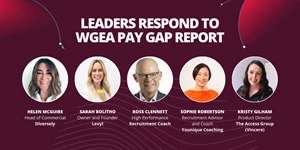Recruitment leaders respond to Australia’s WGEA gender pay gap report: the good, the bad and the ugly
On the 27th of February, The Workplace Gender Equality Agency (WGEA) released data on gender pay gaps (publicly available here) which was collated based on the findings of 5,000 individual private sector employers with 100 or more employees, and the evidence is compelling and unequivocal.
While the publication of gender pay data represents a critical milestone for gender equality in Australia, the subsequent actions, particularly within the recruitment industry, hold greater significance. To understand these implications, we consulted with several leaders in our community for their insights.

“Is the wage gap real?” For the first time in history, we finally have evidence-based answers to this critical question.
On the 27th of February, The Workplace Gender Equality Agency (WGEA) released data on gender pay gaps (publicly available here) which was collated based on the findings of 5,000 individual private sector employers with 100 or more employees, and the evidence is compelling and unequivocal.
Key headlines from the report:
- The total remuneration pay gap between Australian men and women is 21.7%. This gap is calculated on base salary, overtime, bonuses and additional payments.
- On average women in Australia earn $26,393 less than men yearly.
- Only 22% of CEOs in Australia are women.
- Overall, men constituted only 14% of all recipients of paid primary carer parental leave, marking a modest increase of 0.6% from 2022 to 2023. [Source]
While the publication of gender pay data represents a critical milestone for gender equality in Australia, the subsequent actions, particularly within the recruitment industry, hold greater significance. To understand these implications, we consulted with several leaders in our community for their insights.
Gender pay gap data at 21.7% paints a stark picture of Australia’s biggest and most recognisable employers
We’ve interviewed five recruitment industry thought leaders for their opinions on the data released by WGEA. When asked if they were surprised by the findings, the majority said the results were similar to what they were expecting, if not lower.
“It’s on par with what I expected,” shared Sarah Bolitho, founder and owner of Levyl, a specialist HR and People and Culture Recruitment Agency. “And that's off the back of knowing that I think representation of women across executive-level positions in Australia sits at about 22%. So, when you consider that, that means that men currently dominate 78% of CEO roles in Australia. I think it's fair to assume that the gender pay gap would also be quite stark when you're looking at those kinds of statistics.”
“Unfortunately, nothing surprised me.” remarked Kristy Gilham, product director at The Access Group (Vincere) “Except perhaps some of the attitudes towards the findings. There is still a sentiment of 'just get a better paying job' among some parts of the population rather than understanding that many industries that are female-dominated continue to be undervalued in comparison to more male-dominated industries, such as marketing compared to engineering for example.”
Ross Clennett, High-performance recruitment coach and Director of rossclennett.com, revealed that the gap was “slightly lower than what (he) was expecting given how many men are in higher earning jobs/sectors e.g. CEOs, mining and women are employed in large numbers in lower-paying jobs like aged care, childcare, hospitality, teaching etc.”
Change starts from the top: Where are the women?
According to WGEA’s report, 57% of the surveyed organisations have a male-dominated management team.
“There is a huge disproportion of women to men in leadership roles and I find that to be the norm”, said Kristy. “We also need to consider many women may have career gaps due to still primarily being the primary caregivers and the skills they often pick up during those gaps are also valuable. I know I use my mum voice when needed in my role as a manager! As well as time management etc.”
Sarah echoes similar sentiments: “Current industry landscapes show male domination in certain sectors and female predominance in others. Yet, even in female-oriented sectors, what we see through this data is that men largely occupy leadership positions, contributing to significant pay disparities. This reflects unseen societal and professional barriers for women, leading to their dropouts and missed opportunities in the workforce.”
Does it matter whether an industry’s employment is dominated by one gender? In terms of numbers, Ross shared on his recent blog. that “male-dominated sectors reported a 24.1% pay gap. For gender-balanced industries, the gap dropped to 11.9% although female-dominated industries still saw a 10.8% gap suggesting that the most highly paid roles in those sectors are male-dominated.”
"The fact that over a quarter of companies have no female representation at board level and only 25% are equally balanced is deeply worrying and no doubt informs the large gender pay gap,” shared Helen McGuire, Head of Commercial at Diversely. “Without gender balance at the top, it is hard for the incumbent board to be driven to change throughout the organisation – there is no incentive or pressure on those making the key decisions, i.e. majority of men, to change the status quo.”
Parental leave parity: could this be the missing piece to the gender pay gap puzzle?
When asked what an effective solution to close the gender pay gap might be, leaders agreed that initiatives promoting parental leave and flex-time policies were critical.
Sophie Robinson, Recruitment Advisor and Coach at Younique Coaching said, “The gender pay gap is about equity, so companies need to encourage women to apply for more senior jobs. Give women access to senior roles regardless of time taken for maternity leave and for caring duties.”
For Helen, “the lack of uptake by men on parental leave – currently standing at just over 1 out of 10 men and almost 40% of employers not offering more than is statutory as paid maternity leave. Action at the government level to mandate fairer parental leave policies and include fathers in this approach would be a huge leap forward to solving the drop off between lower, mid-levels and representation and those at board level.”
Sarah noticed an anomaly in the WGEA report: “It wasn't clear in the report how many organisations offer gender-neutral parental leave, or carer-neutral parental leave”. Sarah remarked “An important piece in the gender pay gap puzzle is the consideration of the family and carer obligations employees have outside of their work environment. This includes activities including raising children, caring for elderly parents or other household responsibilities that traditionally, women took on. I think that parental leave and flexible arrangements for both men and women is an important piece of the puzzle, yet, what was quite stark to me was to see how a lower proportion of men are taking up parental leave.
A consideration of Sarah’s was if there was a progression of flexible policies across the board, would the adoption of these policies by men increase? And would it help the workforce balance out the representation of getting more women into female leadership roles to reduce the gender pay gap?”
What does this mean for recruitment?
Our panel of consultants are unanimous in their view that organisations are expected to be forthcoming about workplace policies and prioritise the attraction and retention of women.
The government may have hinted at potential changes to supplier criteria for government contracts, but until that happens, recruitment firms and hiring organisations ought to be mindful of how they hire and how they are perceived by the market.
Sophia shares, “As a consumer, I am interested in which companies do the right thing as I can actively choose where to spend my money as a signal to the worst companies that they can and need to do better. A big surprise to me was how poorly companies that specifically cater to women did.”
“If recruitment companies aren’t interested in minimising or eliminating the gender pay gap, they should at least consider that this may be a criterion in future for Government and Corporate tenders. If it affects their bottom line, this may incentivise them to do something about it. It will also be an attraction and retention strategy for the long-term.”
Ross predicts that “more hiring managers will be conscious of ensuring women are included on shortlists for senior roles and doing more to retain the senior women they already have, i.e. by being more flexible.”
According to Sarah, “Organisations will be forced to think critically about what they are doing to support women in the workplace and how they are articulating that in the EVP to market”. “Their EVP pitch will need to include parental leave policies, and workplace flexibility and for those organisations with a significant gender pay gap it will also need to include what they are doing to close the gap. As recruiters, we then take the organisations’ EVP and use it to market the company to candidates.”
For Helen, it’s all about training recruiters to be consultative and ask the right questions. “Questions recruiters can start to ask include: Can we look at where there may be transferable skills here at more senior levels to increase the levels of women within the industry? Can we attract talent from other industries and steal a march on our competition by fishing from wider pools than all our competitors? How can we differentiate ourselves and our culture to make this possible? These are all the things I’d be asking to help increase gender representation and therefore the skills base in various under-represented industries.”
Closing the gap starts with accountability and action
According to Helen, “Only 70% of the 5000 or so companies surveyed have a policy of gender pay equity; of those who have a gap only half undertook analysis to understand it and just 60% of those took any action to resolve it”.
Sarah believes that the release of the data provides Australian businesses and the recruitment industry with the opportunity to identify why there is a gender pay gap, where there is room for improvement and what can be done to close the gender pay gap.” Up until this point, there just hasn't been enough discussion about why there is a gender pay gap, who is contributing to it and what we're doing to drive accountability to close the gap. So now, with the data being public, I think that's a huge opportunity for Australia and the recruitment sector to get behind that and go. We know what we're working with, what we are doing to win influence, drive positive change and take a step in the right direction.”
Sarah has developed a DE&I program, called the High Potential Program for her company, Levyl, that facilitates making identified hires within people and culture teams. “I created this program to challenge the day-to-day conversations and opinions. With the HPP it shows our clients that it doesn’t cost much to get started and that they have a vital role to play in the market to create a deliberate and strategic investment in the future workforce.”
Further suggested activities included this suggestion from Kristy, “There are tools out there like Diversely that can be easily implemented to help recruiters make unbiased decisions.” Helen added, “ensuring that language is tackled in job ads and across websites to speak inclusively across genders and underrepresented groups; looking to seek talent in new places – not just from existing networks or based on what’s worked previously – and anonymising profiles to ensure fair assessment of candidates coming into a pipeline are all key to mitigating biases so that past processes don’t impact future results. Software, such as Access Volcanic, provides exactly this.”
Will the gap narrow?
We’ll let the leaders give their crystal ball predictions.
Ross predicts, “Yes, it will but slowly - a consistent 1 percentage point decline for each of the next ten years would be slower than we all want but I expect it's the most realistic we can expect. It takes a long time for these differences to move through the system (i.e. higher-paid men stay with their employer for longer because it's harder to get a higher-paying external job the older you are, above 45 at least).”
Sarah reflected “Following World Economic Forum estimation it will take around 100 years to reach gender equality on a global level”. To achieve gender equality, Sarah thinks that “it will take time but we're on a stronger journey for it now.”
Sophia predicts “it will take 132 years to close the gap”. But she is so “optimistic that publishing this important data will speed the process up as we have seen it do in the UK.”
It seems to move the dial on equality, we need unbiased thinking, systems and processes. Helen sums it up nicely, “none of this will make a lasting impact without internal culture, inclusion and belonging strategies being in place by the companies themselves.” To drive change, it must be combined with leadership accountability, and a supportive culture.
No organisation can achieve equality overnight. We need to be deliberate in creating a workplace where diversity thrives.
The jury is still out on how Australia will be accelerating the gender pay gap. What’s your view?
Access Recruitment Solutions
Partnering with agencies of all sizes to provide a recruitment software solution to attract, manage and pay high-caliber candidates faster and more efficiently than ever. We are the only vendor to offer staffing agencies an entire spectrum of recruitment software, including CRM/ATS, Pay & Bill software, and a Winning recruitment website.









